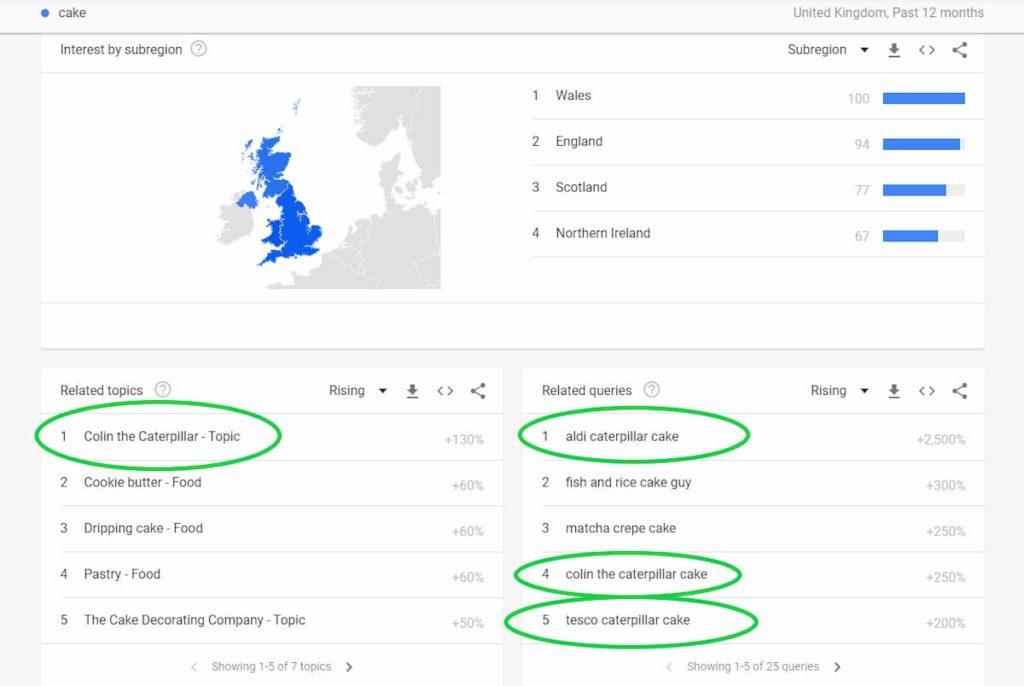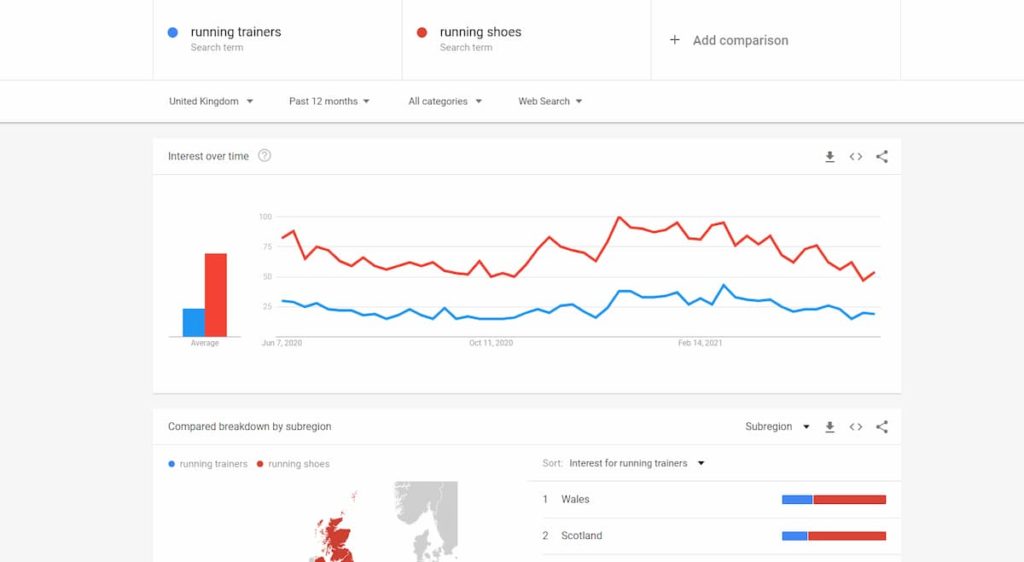All good content starts with a topic idea. With over 1.94 billion websites on the internet today, creating distinctive content that stands out to users has become more challenging. Being recognised as a useful and authoritative source of content is the gold standard for many websites. However, with so many competitors promoting similar topics, keywords can be the deciding factor regarding the visibility of your content.
What is a keyword?
A keyword is defined by Yoast as a ‘word that describes the content on your page or post best.’ They make up the focal point of your website or blog and provide search engines with context which can be used to assess the relevancy of your content. The essential purpose of focusing on a keyword or key phrase is to optimise a website in order to rank higher in search results for those terms.
Why Keyword Research Matters
Keyword research is hugely important for informing a successful content strategy and means that you are more likely to see more relevant traffic coming to your site. Generally, having a method for keyword research is best practice and will boost your search engine optimization (SEO).
It is crucial to conduct keyword research to understand what people are searching for. Although you may believe you know exactly what your audience would be searching for to find your website, what you think may not align with the reality being demonstrated in the data.

Understanding search intent
When somebody Googles a question, the results displayed are based upon what the search engine interprets as the searcher’s intent, or the meaning behind the search.
It is tempting to get carried away when compiling potential keywords, but you should always think about what the search intent is behind those terms. Consider what the user is looking for when searching for the keyword. Conducting a simple Google search can be incredibly useful. If your blog post or website is similar to what you see in the results, the keyword is then an appropriate option to go for. In Google’s Quality Rater Guidelines, Google explains the 4 major intents that searchers have:
- A ‘Know’ query, some of which are ‘Know Simple’ queries. ‘Know Simple’ queries seek a very specific answer, like a fact, and can usually be answered within a few sentences.
- A ‘Do’ query, some of which are ‘Device Action’ queries. ‘Device Action’ queries are where users have asked their phone or smart assistant to do something for them.
- A ‘Website’ query, where a user is looking for a specific website or webpage.
- A ‘Visit-in-person’ query, some of which are looking for a specific business or organisation, and some of which are looking for a category of businesses.
In essence, these can be divided into ‘informational’, ‘transactional’, ‘navigational’, and ‘local’. As you begin to accumulate a list of keywords, by testing them in Google, you can work out what Google has decided the intent of that phrase is.
Example
If you search for ‘stilettos’, you’ll see a search engine results page that displays mixed search intent. There will be a shopping carousel of stilettos being promoted at the top of the page, and then a knowledge panel in case you were looking for a definition, and finally a local map to cater for users who wanted to buy stilettos near their location.
This shows that Google has determined the user has a transactional search intent. However, it cannot work out if they want to buy online or at a local shop. It, therefore, shows all possible options in the hope that one of them is the best fit for that query.

Head term or long tail keyword?
To conduct effective keyword research, you must compile a list of potential keywords or phrases that relate to the mission and purpose of your business. During this stage, try to think of a range of keyword lengths, from short broad terms to longer specific phrases.
A head term usually revolves around a general broad topic that has a vast amount of content written about it. Even though these terms generate a lot of traffic, it is unlikely to amount to much if you appear far down the search results.
A long tail keyword tends to be a keyword or phrase that is a subtopic of the head term. These have fewer search results as well as less competition in the market as there is less content written on the niches. This is crucial to keep in mind when you go on to look into the search intent of your audience. Long tail keywords also mean you are likely to see more conversions from the niche audiences if you are fulfilling their specific demand.
Example
Let’s say you own a bakery, trying to rank for the keyword ‘cake’ is likely to be difficult due to the broadness of the term and those searching for it may be looking for varying results. Some users may be looking for recipes and others may be looking for shops to place an order. Likewise, trying to rank for ‘dairy free pineapple upside down cake’, although it is more specific with less competition, it will not generate as many searches due to its niche target audience.
How To Choose The Best Keyword
Using tools such as an organic Google search to see what appears in the suggested searches is a simple way to see what people are looking for. You can also take a look at the search results and see if the displayed sites align with your brand. Another incredibly useful tool is Answer The Public which gives you a plethora of relevant searches based on their popularity. This can provide valuable information for your keyword research and understanding its real-world implications for searchers.
When conducting keyword research, ask yourself the following key questions:
- Who are you trying to reach?
- What sort of search terms do you want to appear for?
- How can the search terms be posed as questions?
- Are there any long tail ways of wording your keyword?
- Can you provide solutions to any issues encountered in your industry?
- What topics are currently trending, both in general and within your industry?
Remember, with short broad terms you may find it significantly harder to rank as these words are already likely to be saturated with competitors. Likewise, targeting long and incredibly specific phrases are likely to mean you will rank higher, but these tend to also receive less searches and traffic. However, this means that you may be able to fill this demand. Generally, you should try to find some middle ground between saturated terms and niche ones.

What is trending?
Taking a look at what topics are currently trending is a useful way for you to steer your content and what you want to rank for. Again, relevance is key, do not try to rank for something where your content does not match the search intent as you risk being penalised.
A useful tool when looking into what topics are trending is Google Trends, which allows you to filter by demographic and time period to search for what is popular. It also displays various overviews regarding different topics, which can also be helpful. Checking in with Google Trends is useful for crafting that current and topical content which more people are searching for.
Returning to the bakery example, if you checked in with what was trending for ‘cake’ on Google Trends, you may have noticed an opportunity to write a blog post about the Colin The Caterpillar vs. Cuthbert The Caterpillar dispute. Due to the relevance of the bakery’s website and content, this would be a great opportunity to become involved with a trending topic. Keeping an eye out for relevant trends is a great way to appear current and aware of topical discussions.

Realistic search language
Along the same lines as search intent, it is easy to become engrossed in thinking of a variety of ways to describe your product, blog or website. However, you may find that you begin to stray from using phrases that people actually search for regarding your product.
Looking into search intent can prevent this issue, but it is still important to be thorough and understand what your audience is looking for. Bear in mind that users may not search for the exact words you use when describing your product or service. This can even apply to whether searchers are using singular or plural terms such as ‘designer’ or ‘designers’. You should therefore try to compare these to identify which ranks better and which has more saturated results.
Example
If you own a sports shop selling a range of trainers for running, you may be tempted to rank these as ‘running trainers’. However, as you can see in the graph below, people are far more likely to search for ‘running shoes’, making it to better term to market for.

Switching out words with synonyms to test how they rank is a great way to avoid missing opportunities, so long as it still holds its relevance. Similarly, opting for ‘running trainers’ may cause confusion with search intent, as some people may be looking for fitness experts rather than footwear. This term may therefore bring up a mixture of results that make it more difficult to rank highly for the concept you are looking for.
Competition
As touched on previously, sometimes the keywords you find are applicable, but in a highly competitive market. Try to be realistic when considering what your content can rank for, you can always try to optimise for long tail terms, which are more likely to convert your audience due to meeting a specific demand or request. There is no harm in ranking for long tail keywords and eventually shortening them as your content marketing strategy grows.
For example, if you own a jewellers and you attempt to rank for ‘jewellery’, you are likely to find it too hard to see results due to the saturated competitor market. Where possible, try to rank for unique selling points about your business and what makes you special. For the jewellers example, you may craft bespoke pieces, so you could try ranking for ‘custom jewellery’ or ‘bespoke jewellery’.
Likewise, if you want to rank a blog post, you can review your article to see what you feel specifically describes the content. For example, you may have written a post on historical jewellery trends, you could try ranking for ‘vintage jewellery’, ‘jewellery history’ or ‘period jewellery’.
How to build your Keyword List
Start compiling relevant keywords
Reflecting on what you have taken from the previous sections, begin by writing out the topics that are most important to your business. These include what your own priorities are, as well as what your customers will be looking for.
Group these by theme and priority. For example, are users more likely to search for certain terms to find out more information, or will they have a transactional intent instead? List anything that springs to mind, because you can trim down the list later on. For now, focus on coming up with as many relevant keywords as possible.
Refine and prioritise your keywords
Revisit your list and work out if there are any variations that can be taken advantage of. The ‘People Also Ask’ widget in Google suggests alternative questions based on similar searches, providing another free method of adding to your keyword research.
Then, to make things more organised, you can separate your keyword list between ‘Head term’ and ‘long tail’ keywords. Your keyword research must strike a balance between hitting these high volume terms and the long tail phrases. There is a great deal of potential in the long tail terms, as people are increasingly reliant on voice search to gather information from search engines.
Assess which keywords to target
Compare how much work it will take to rank highly for a phrase that is particularly relevant to your business and your customers’ search intent. It will be more labour intensive to rank for difficult phrases with a lot of competition. However, if targeting a few of those terms will contribute towards your site traffic and increase the odds of customer conversion, then it may pay off.
Once you have sifted through your list to decide which phrases you’re going to target, your keyword research is complete. Those core phrases form the basis of your optimisation strategy. You are now ready to begin inserting these keywords and phrases into your website’s copy, and measuring the results.
Write and amend your website’s copy
It is not necessary to create an entirely new page for every keyword. As the Google algorithm is continually being refined and developed, it can group similar concepts by how they are related. It, therefore, recognises synonyms and related terms.
It is important to have a page for every key concept you want your website to rank for. These lead through to pages that are more detailed and use specific long tail keywords. The content that you incorporate keywords into does not need to necessarily be written. Vary your content with a mixture of video, graphics and images to maximise engagement, depending on what your audience is looking for.

The final key to successful keyword research for websites is to monitor your success. Regularly check your analytics data and rank metrics to see if certain content is performing better than others. You may not see instantaneous results depending on the terms you have selected.
Remember to act on what the data is telling you. Optimise everything from title tags to image alt text. In addition, make sure you are working up your old content as well as producing new content. Consistent, sustained chipping away at keyword research is essential in order to see results.
The Yoast Plugin
Once you have collected the suitable keywords for your blog or website, we recommend you check how well your content is utilising them through the Yoast plugin. You should bear in mind that Yoast advises for 1-2% of your copy to be your keyword. However, the plugin will identify how well your keyword applies to your content by displaying a traffic light system.
This system is simple, with green being good, orange being okay, and red meaning it needs improvement. Consider the recommendations made by the plugin and consider adjusting your content for a new keyword if need be. Despite this, you should avoid making changes that will be detrimental to the quality of your copy or the user experience.
What to avoid
Optimising for specific keywords as opposed to broader terms becomes even more important ranking your other pages or blogs. It is crucial you don’t optimise multiple pages for the same keyword. This will mean you are essentially competing with yourself and Google won’t know which of your pages to rank first.
This is known as keyword cannibalisation and can have a significant impact on your SEO. It is essential to be specific and tailored to each page when informing your content strategy.
Summary
Overall, keywords play a vital role in SEO and ranking your content. Conducting keyword research and avoiding pitfalls can produce better results for your website as well as boosting the overall quality. Identify what your audience is looking for, how they phrase it, and whether your proposed terms align with the results.
Be realistic with your ranking and what types of terms and phrases you want to rank for. Consider the type of business you operate and whether long tail or short keywords are most suitable.
If you are looking for support with your keyword research, please see our marketing communications services or email us at customerservice@mackman.co.uk
